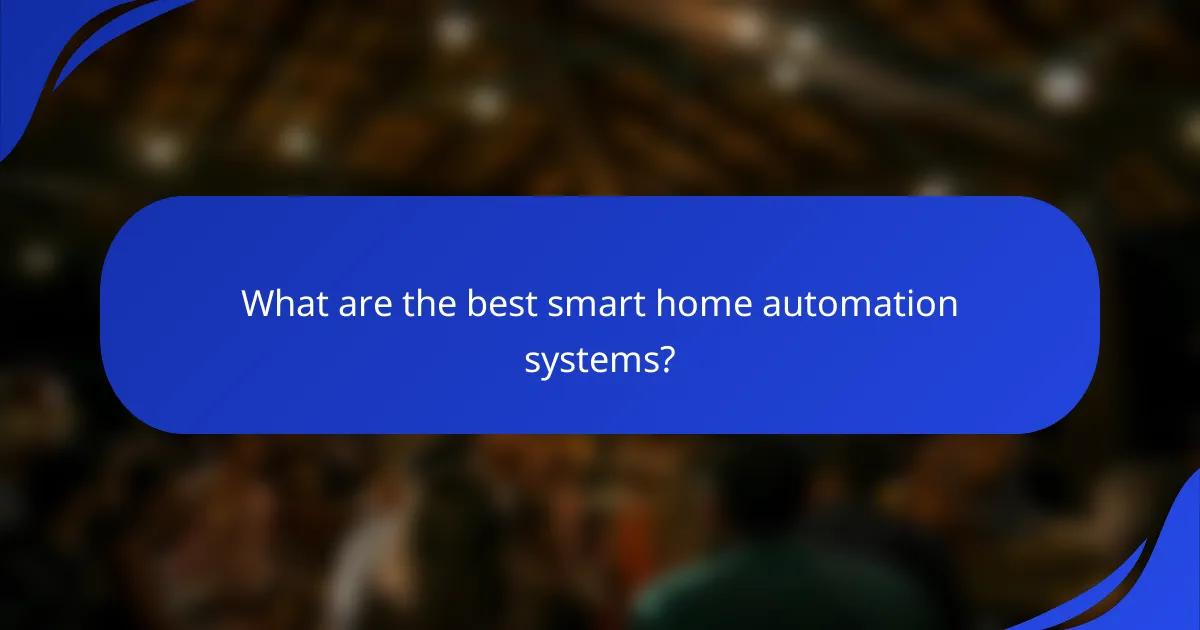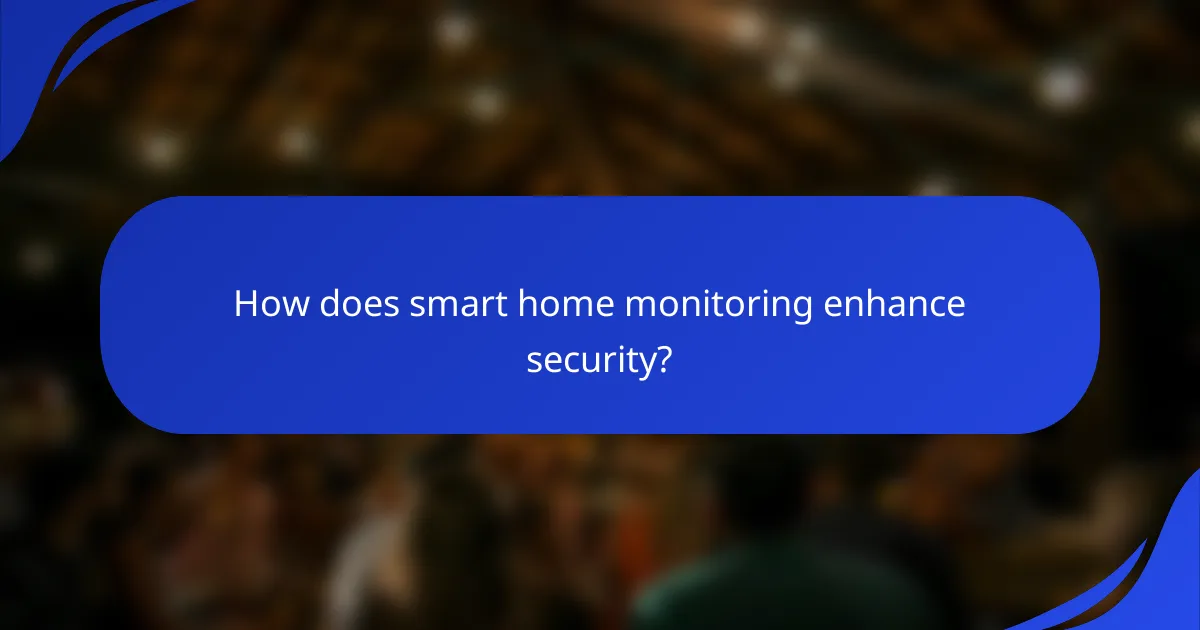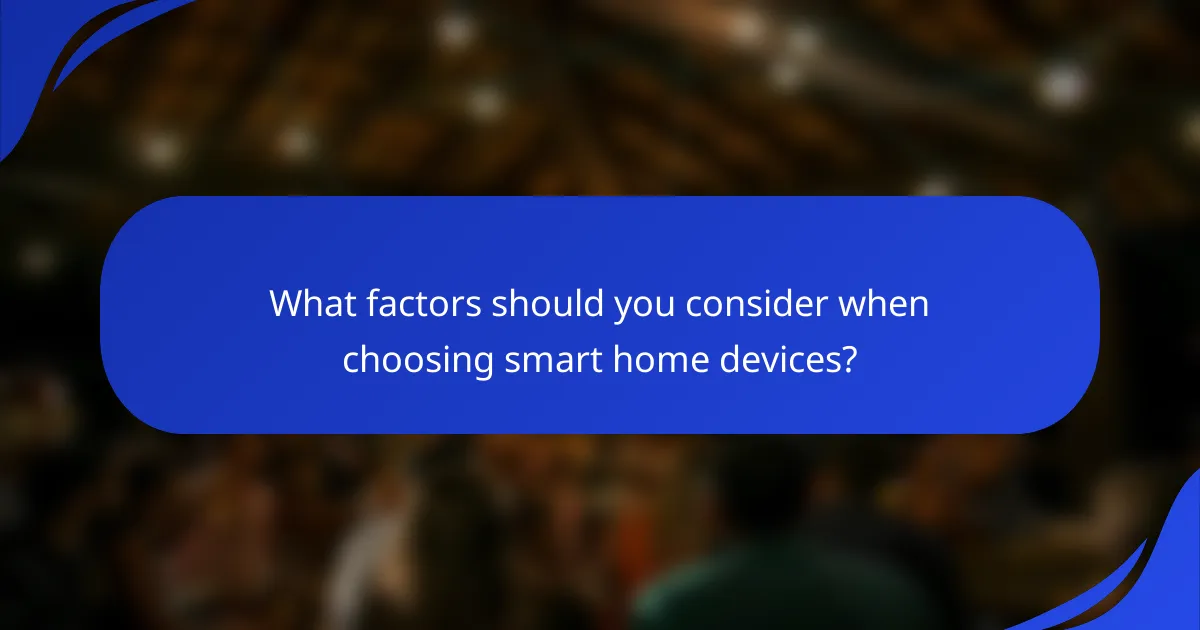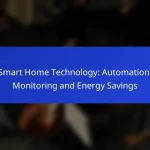Smart home technology revolutionizes the way we manage our living spaces by automating tasks, enhancing security, and promoting energy efficiency. By integrating devices like smart thermostats and monitoring systems, homeowners can optimize energy usage, reduce costs, and ensure their properties are secure. With options such as Amazon Alexa, Google Nest, and Apple HomeKit, selecting the right automation system can tailor your smart home experience to your specific needs.

How can smart home technology improve energy savings?
Smart home technology can significantly enhance energy savings by automating and optimizing energy consumption in various household systems. By integrating devices such as smart thermostats and energy-efficient lighting, homeowners can reduce waste and lower utility bills.
Smart thermostats
Smart thermostats adjust heating and cooling based on your schedule and preferences, ensuring that energy is not wasted when you’re not home. Many models allow remote access via smartphone apps, enabling you to modify settings on the go.
Consider models that learn your habits over time, which can lead to further savings. Look for features like geofencing, which adjusts the temperature based on your location, and energy reports that help you track usage patterns.
Energy-efficient lighting
Switching to energy-efficient lighting, such as LED bulbs, can drastically reduce electricity consumption. LEDs use up to 80% less energy than traditional incandescent bulbs and last significantly longer, which means lower replacement costs.
Implementing smart lighting systems allows for automation and remote control, enabling you to schedule lights to turn off when not needed. This can further enhance savings, especially in high-usage areas like living rooms and kitchens.
Smart power strips
Smart power strips help eliminate phantom loads by cutting power to devices that are not in use. These strips can detect when devices are in standby mode and automatically turn them off, preventing unnecessary energy consumption.
When choosing a smart power strip, look for models with energy monitoring features that provide insights into usage patterns. This can help identify devices that consume excessive energy and guide you in making more efficient choices.
Automated blinds
Automated blinds can optimize natural light and temperature control, reducing reliance on heating and cooling systems. By programming blinds to open and close based on the time of day or temperature, you can maintain a comfortable indoor environment while saving energy.
Consider integrating these with your smart thermostat for a comprehensive energy-saving strategy. For example, closing blinds during peak sunlight hours can keep your home cooler, reducing air conditioning needs.
Energy monitoring systems
Energy monitoring systems provide real-time insights into your household’s energy consumption, allowing you to identify high-usage appliances and adjust habits accordingly. These systems can track usage patterns and suggest ways to improve efficiency.
Many energy monitors can be integrated with smart home platforms, enabling alerts and automation based on energy usage thresholds. This proactive approach can lead to significant savings over time, especially if you regularly review and act on the data provided.

What are the best smart home automation systems?
The best smart home automation systems include Amazon Alexa, Google Nest, and Apple HomeKit, each offering unique features and compatibility with various devices. Choosing the right system depends on your existing devices, preferred ecosystem, and specific automation needs.
Amazon Alexa
Amazon Alexa is a versatile smart home automation system that integrates with a wide range of devices, from lights to thermostats. It operates through voice commands, allowing users to control their smart home with simple phrases.
Consider compatibility when selecting Alexa devices; many brands support Alexa, making it easy to expand your system. However, be mindful of privacy concerns, as Alexa continuously listens for commands.
Google Nest
Google Nest focuses on seamless integration with Google services and offers a user-friendly interface. It supports various smart devices and can be controlled via voice commands through Google Assistant.
One advantage of Google Nest is its ability to learn user preferences over time, optimizing automation based on your habits. However, ensure your devices are compatible with the Google ecosystem to maximize functionality.
Apple HomeKit
Apple HomeKit is designed for users within the Apple ecosystem, providing a secure and privacy-focused automation experience. It allows control of compatible devices through Siri and the Home app on iOS devices.
HomeKit’s strength lies in its robust security features, but it has a more limited range of compatible devices compared to Alexa and Google Nest. If you prioritize privacy and already use Apple products, HomeKit is a solid choice.

How does smart home monitoring enhance security?
Smart home monitoring enhances security by providing real-time surveillance and alerts, allowing homeowners to respond quickly to potential threats. These systems use various devices to monitor activity and ensure that your property is protected at all times.
Smart cameras
Smart cameras are essential for monitoring both the interior and exterior of your home. They can stream live video to your smartphone or tablet, enabling you to check in on your property from anywhere. Many models offer features like night vision, motion detection, and cloud storage for recorded footage.
When selecting smart cameras, consider factors such as resolution, field of view, and whether they require a subscription for cloud services. Look for models that integrate with your existing smart home ecosystem for seamless operation.
Smart doorbells
Smart doorbells combine a camera with a two-way intercom, allowing you to see and communicate with visitors at your door remotely. They often send alerts to your phone when someone approaches, even if they don’t ring the bell. This feature enhances security by allowing you to monitor who is at your door without opening it.
When choosing a smart doorbell, check for features like video quality, motion detection sensitivity, and compatibility with your home’s Wi-Fi network. Some models also offer package detection, alerting you when deliveries arrive.
Motion sensors
Motion sensors detect movement in specific areas of your home and can trigger alerts or activate other smart devices, such as lights or cameras. These sensors can be placed indoors or outdoors to create a comprehensive security perimeter. They help deter intruders by making it clear that your property is being monitored.
For effective use, position motion sensors in high-traffic areas and ensure they are compatible with your smart home system. Consider whether you prefer passive infrared sensors, which detect heat, or active sensors, which use beams of light. Regularly check and maintain the sensors to ensure they function correctly.

What factors should you consider when choosing smart home devices?
When selecting smart home devices, consider compatibility with your existing systems, ease of use, and your budget. These factors will help ensure that your smart home setup is efficient, user-friendly, and financially viable.
Compatibility with existing systems
Before purchasing smart home devices, check their compatibility with your current systems, such as Wi-Fi networks, smart hubs, or voice assistants. Devices that work seamlessly together can enhance functionality and user experience.
For instance, if you already have a smart speaker like Amazon Echo or Google Nest, look for devices that integrate well with these platforms. This can save time and reduce frustration during setup.
Ease of use
Choose smart home devices that are intuitive and user-friendly. A complicated interface can lead to frustration and decreased usage, negating the benefits of automation.
Look for devices with mobile apps that offer clear instructions and easy navigation. Features like voice control can also enhance usability, making it simpler to manage your smart home.
Cost and budget
Establish a budget before shopping for smart home devices, as prices can vary widely. Consider both the initial purchase price and any ongoing costs, such as subscriptions for premium features or energy consumption.
Many devices are available at various price points, so compare features to find the best value. Aim for a balance between quality and affordability to ensure you invest wisely in your smart home technology.

What are the latest trends in smart home technology?
The latest trends in smart home technology focus on enhanced automation, improved energy efficiency, and advanced monitoring capabilities. Innovations such as AI integration, voice control, and interoperability among devices are shaping how homeowners interact with their environments.
Automation and AI Integration
Automation in smart homes is increasingly driven by artificial intelligence, allowing for more intuitive and responsive systems. Smart devices can learn user habits and preferences, adjusting settings automatically based on patterns, such as lighting and temperature preferences throughout the day.
For example, smart thermostats can optimize heating and cooling schedules based on occupancy and weather forecasts, potentially reducing energy costs by a significant margin. Homeowners should consider systems that offer machine learning capabilities for the best user experience.
Energy Monitoring and Savings
Energy monitoring is a key trend, enabling homeowners to track and manage their energy consumption in real-time. Smart meters and connected appliances provide insights into energy use, helping identify areas for savings.
Implementing smart plugs and energy-efficient appliances can lead to reductions in electricity bills. Homeowners can save tens of percent on their energy costs by using devices that provide usage data and suggestions for optimization.
Enhanced Security Features
Smart home security systems are becoming more sophisticated, incorporating features such as facial recognition, motion detection, and remote monitoring. These systems allow homeowners to receive alerts and view live feeds from their devices, enhancing peace of mind.
Investing in a comprehensive security system that integrates with other smart home devices can provide a cohesive experience. Look for systems that offer easy installation and compatibility with existing devices to maximize effectiveness.
Interoperability and Ecosystem Integration
Interoperability among smart devices is a growing trend, allowing various products to work seamlessly together. Homeowners are increasingly looking for solutions that can integrate with multiple platforms, such as Google Home or Amazon Alexa.
Choosing devices that support common communication protocols, like Zigbee or Z-Wave, can enhance connectivity and functionality. This integration can simplify control and improve the overall smart home experience.






